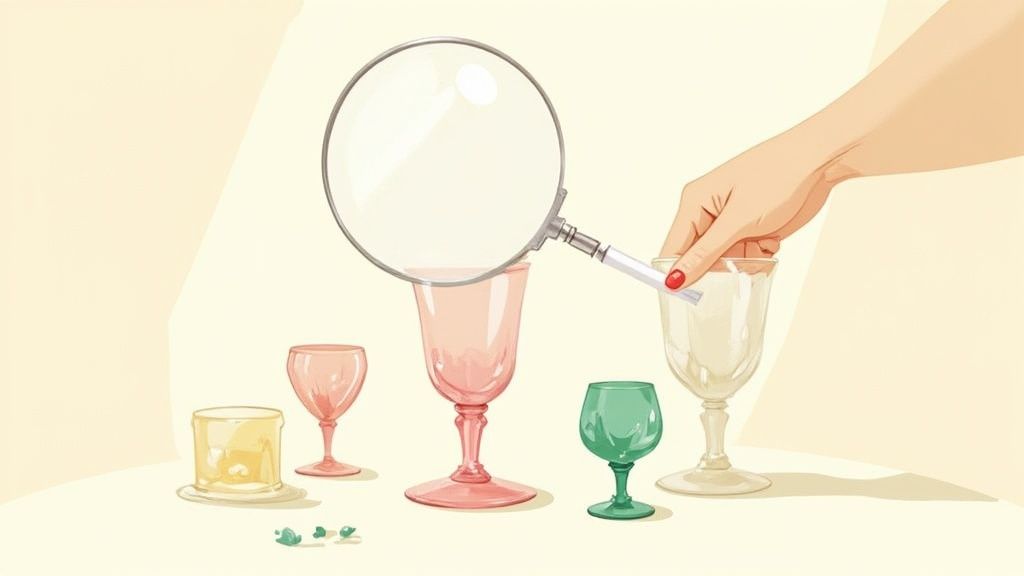When you first pick up a piece of glass you think might be vintage, your best tools are your own eyes and hands. Before you even think about maker’s marks or patterns, the physical characteristics of the glass itself can tell you so much. Older manufacturing methods were far from perfect, and those little quirks are exactly what we're looking for.
Things like slight asymmetry, visible seams from a mold, tiny bubbles trapped inside the glass, and pontil marks on the bottom are all clues. These imperfections are the storytellers, hinting that a piece was handmade or created in an early machine-assisted era, setting it apart from modern, mass-produced glassware.
Your First Steps in Glassware Identification
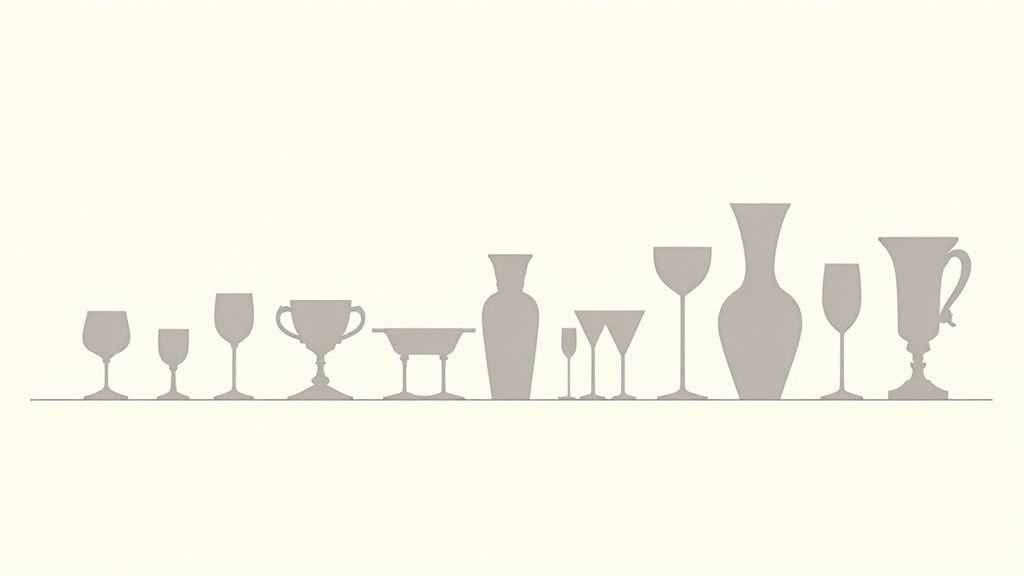
Jumping into the world of vintage glassware can feel like learning a whole new language. Before you get overwhelmed by catalogs of patterns and lists of obscure maker’s marks, it's best to start with the fundamentals—the things you can see and feel right away. This initial assessment is all about training your eye to spot the subtle hints that scream "vintage find" instead of "modern reproduction."
So many seasoned collectors I know got their start just by picking up every interesting glass they stumbled upon in thrift stores and at flea markets. There’s really no substitute for that hands-on experience. You begin to develop an instinct for the weight and texture of older glass, which often has a certain heft and substance that you just don't find in most contemporary pieces.
Look for Signs of Imperfection
Unlike the flawlessly uniform glassware we see today, vintage items are full of charming "flaws" that reveal how they were crafted. Think of them not as defects, but as hallmarks of age and human touch. Don't just give a piece a quick glance; hold it up to the light, turn it over, and really inspect it.
Here are some of the most common signs you're holding something special:
- Bubbles: Tiny, trapped air bubbles are a classic sign of older, hand-blown glass or early machine-pressed pieces. Modern manufacturing has all but eliminated these.
- Straw Marks: These look like fine, straight lines or faint scratches on the glass surface. They happened when the hot glass was placed on straw or other materials to cool.
- Asymmetry: A slightly lopsided shape, an uneven rim, or a pattern that’s just a little off-center all point to hand-finishing, not the precision of a modern machine.
- Pontil Marks: This is a dead giveaway for hand-blown glass. Look for a rough, circular spot on the bottom where the piece was snapped off the pontil rod after being shaped.
A Pro Tip from the Field: Next time you're at a flea market, run your finger along the side of a glass. If you feel a prominent or even sharp seam running up the side, it was likely made in a two-part mold. This was a very common technique for producing Depression-era glass.
To help you make a quick judgment call when you're out hunting, here's a handy table summarizing these initial clues.
Quick Identification Clues for Vintage Glassware
This table gives you a quick-reference guide to the initial visual and physical clues that can help you distinguish a potential vintage treasure from a modern piece at a glance.
| Characteristic | What It Suggests | What to Look For |
|---|---|---|
| Visible Seams | Machine-Pressed Glass | A faint line running up the sides of the piece where mold halves met. |
| Heavy Weight | Lead Crystal or Early Glass | The piece feels surprisingly heavy for its size compared to a modern glass. |
| Rough Pontil Mark | Hand-Blown | A rough, unpolished circular scar on the base, sometimes ground down. |
| Slight Imbalance | Hand-Finished | It might sit a little unevenly or have a charmingly non-uniform shape. |
Using these tells, you can quickly sort through shelves of glassware and focus your attention on the pieces that show the most promise. It's the first and most important step in building your identification skills.
Decoding Maker's Marks and Signatures
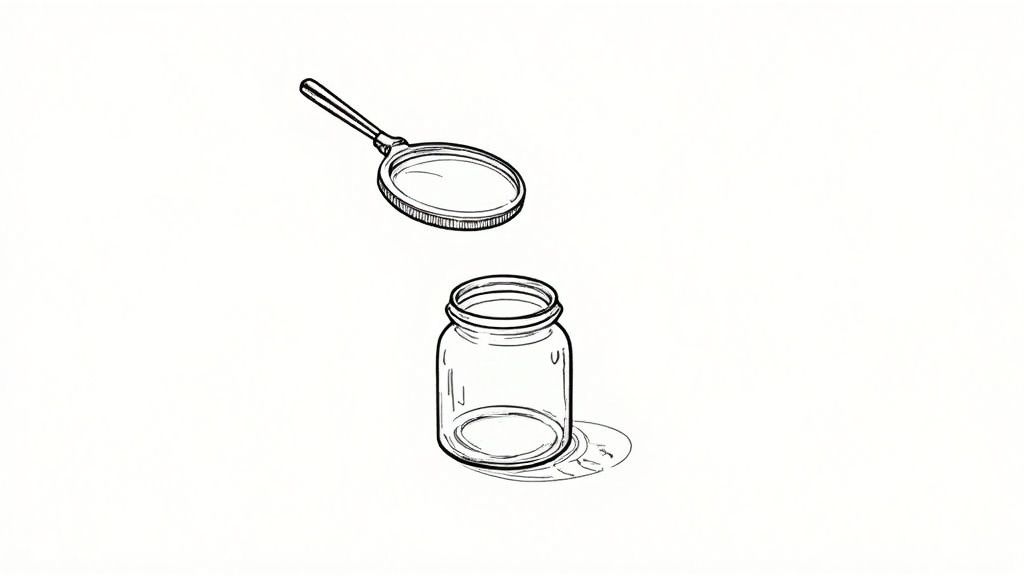
If physical clues like pontil marks tell you part of the story, finding a maker's mark is like getting a signed confession. These little signatures, logos, or symbols are often the most direct route to identifying vintage glassware. Of course, they can also be frustratingly faint or cryptic, but discovering one feels like a real breakthrough.
Your first move should always be to check the bottom of the piece. It’s the most common spot for a mark since it doesn't mess with the design. I always recommend tilting the glass under a bright light, turning it slowly to catch any subtle impressions. Sometimes you can't see a mark, but you can feel it—try running a fingertip gently across the base for any raised or indented areas.
But don't give up if the base comes up empty. I've found marks hiding in some sneaky places over the years.
- Near the Stem: For goblets and wine glasses, inspect the area where the stem meets the foot and where it connects to the bowl.
- On the Lower Body: Pitchers, vases, and tumblers can sometimes have a mark stamped near the bottom edge.
- Within the Pattern: This is the trickiest one. Some makers cleverly integrated their logo right into the decorative pattern itself. It takes a keen eye to spot.
Understanding the Language of Marks
Maker’s marks aren't just names; they're a language. You might find a delicate, frosted logo left by an acid-etched mark. Or you could discover an embossed mark, where the symbol is literally raised from the glass because it was part of the mold.
Famous American glass companies like Fenton, Cambridge, and Fostoria changed their marks over time. For instance, Fenton's earliest work was often unmarked, but later they introduced their iconic "F" inside an oval. A tiny change in that logo can be the difference between a piece made in the 1950s versus the 1970s. This is why just finding a mark isn't the final step; you have to know what it means. It’s a process that has a lot in common with other collectibles; the skills used for how to identify antique jewelry also lean heavily on deciphering these tiny signatures.
A maker's mark is more than just a name; it’s a timestamp. Knowing that the Westmoreland Glass Company used a "W" intertwined with a "G" primarily from the 1940s to the 1980s can instantly place your milk glass piece within a specific historical window.
Connecting Marks to Global Styles
Knowing where a mark comes from is just as important. Different regions had their own signature styles and periods of dominance. Europe, for example, has a long legacy of glassmaking giants in places like Germany and England and once accounted for over 33% of the global glass drinkware market revenue.
This history matters. If you find a mark that seems European, you can start cross-referencing it with the styles and techniques popular in that region during certain eras. This helps narrow down the possibilities significantly and gives you a much richer story behind the piece you're holding.
Getting to Know Iconic Patterns and Etchings
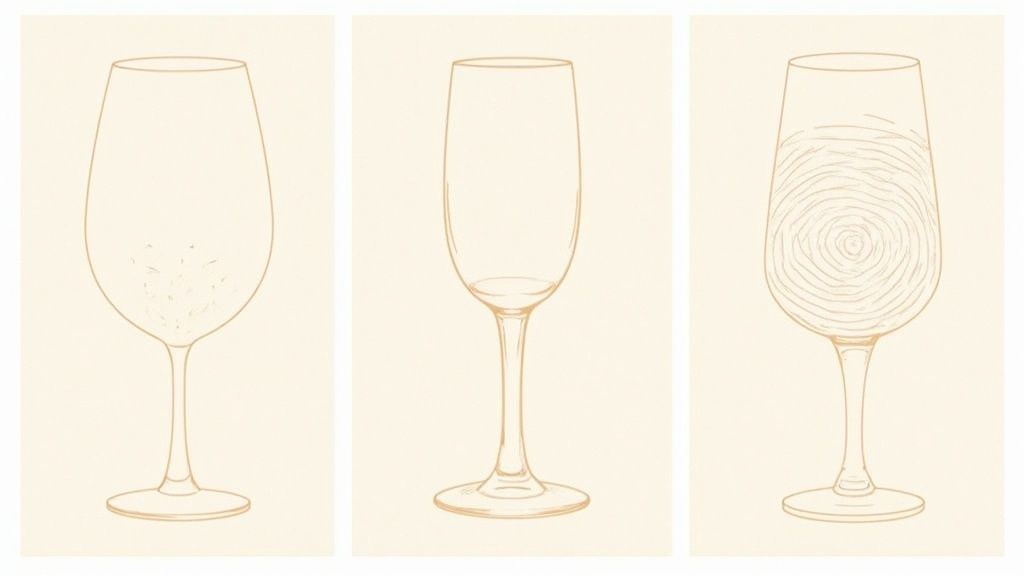
While a maker’s mark is a fantastic starting point, some of the most famous and sought-after vintage glassware is identified by its pattern alone. The big manufacturers all had their signature designs, many of which became household names. Learning to spot these is one of the most satisfying skills you can develop as a collector.
It’s a bit like learning to spot an artist by their signature style. At first glance, everything just looks like "old glass." But with a little practice, you'll soon be able to pick out Fostoria’s geometric "American" pattern from across a crowded antique mall or notice the delicate floral loops of a Heisey "Orchid" etching on a forgotten shelf. These patterns aren't just decoration; they're the unique fingerprint of a brand and a specific moment in time.
The appreciation for these classic designs is growing, too. The global glass tableware market, valued at USD 10.88 billion, is on the rise, driven in part by a new generation of consumers looking for unique pieces with history and character. This means that knowing your patterns isn't just a hobby—it's essential for spotting real value.
Pressed, Cut, or Etched? How the Pattern Was Made Matters
Not all patterns are the same, and the technique used to create the design is a huge clue. How a pattern was applied to the glass can tell you a lot about its age, quality, and where it came from.
You'll generally run into three main types:
- Pressed Glass: This is made by pouring molten glass into a mold to create the pattern. The designs are often geometric or floral and feel a bit rounded to the touch. This method made glassware affordable for the masses, especially during the Depression era.
- Cut Glass: Here, the design is literally cut into a finished piece of glass, either by hand or machine. The patterns are sharp and precise, with deep grooves that catch the light beautifully. Authentic cut glass often feels noticeably heavier because of its high lead content.
- Etched Glass: This technique uses acid to gently eat away at the glass, leaving a delicate, frosted design. Etchings are known for being incredibly intricate, with lots of flowers, vines, and elegant scrolls. The design feels completely smooth, with none of the sharp edges of cut glass.
It’s crucial to know the difference. I’ve seen collectors mistake an elaborate pressed pattern for more valuable cut glass. The tell-tale sign is the feel: the smooth, molded feel of pressed glass is a world away from the sharp, defined edges of true cut glass.
Key Patterns Every Collector Should Know
If you're just starting out, getting familiar with a few legendary patterns will give you a massive head start. These are highly collectible and serve as great reference points for learning. The same principles of observation apply here as they do in other areas of collecting, which you can learn more about in our guide on how to identify antiques of all types.
Keep an eye out for these classics on your next treasure hunt:
- Fostoria "American": You can't miss its blocky, cubist design. This pattern was in production for over 70 years and is a true staple for any collector.
- Jeannette "Cherry Blossom": A classic Depression glass pattern, this one features delicate branches of cherry blossoms. You'll find it in pink, green, and a few other lovely colors.
- Anchor Hocking "Bubble": Simple, charming, and instantly recognizable. This pattern is just concentric rings of raised dots or "bubbles" and was incredibly popular from the 1940s to the 1960s.
- Cambridge "Rose Point": An elegant and intricate etched pattern. Look for a central rose medallion surrounded by what looks like delicate, lacy scrolls.
Once you can spot just a few of these key designs, you'll be much more confident in your ability to pick out the real vintage gems from the reproductions.
Reading the Clues in Color and Glass Type
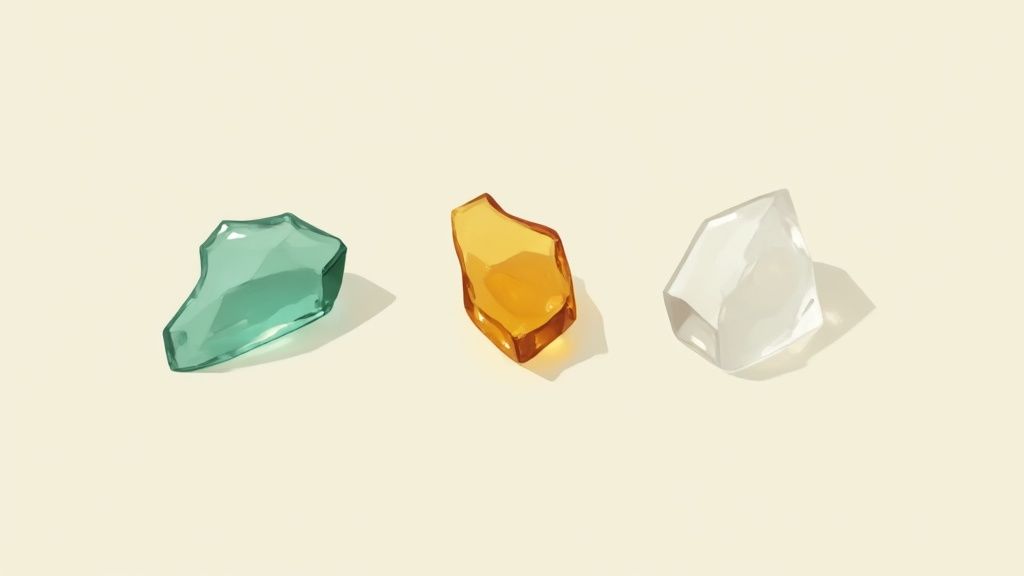
Sometimes, the most obvious clue is staring you right in the face. Beyond intricate patterns or hidden marks, the very color and feel of a glass object can tell you a story about when and where it was made.
Glassware colors followed trends just like fashion, making them excellent signposts for dating a piece. Think of the soft, optimistic pinks, greens, and ambers of Depression glass that brought a little cheer to households in the 1930s. Or fast-forward to the 1970s, when kitchens were awash in bold avocado green and harvest gold.
A quick check can tell you if the color is genuine. True colored glass has the pigment mixed right into the molten material, so the color is solid all the way through. Hold your piece up to a bright light and examine any chips or scratches. If the color is consistent, that's a good sign. If you see it flaking off, you're likely looking at "flashed-on" color—a cheaper technique often used on newer, decorative items rather than true vintage treasures.
The Feel and Sound of the Glass
Once you've looked at the color, it's time to pick up the piece. Different types of glass have surprisingly distinct physical properties. With a little practice, you can learn to identify them by their weight, clarity, and even the sound they make.
It's a tactile experience. Here’s what to look for:
- Lead Crystal: This one is unmistakable. It’s known for its brilliant sparkle and surprising heft. It feels much heavier than you'd expect and sings with a clear, bell-like ring when you gently tap the rim with your fingernail.
- Carnival Glass: You can spot this a mile away. It's a type of pressed glass with a famous iridescent, oil-on-water shimmer. It got its name after failing to sell in upscale markets and being given away as prizes at carnivals.
- Flint Glass: An early American favorite, flint glass is also heavy and remarkably clear. It's known for its incredible resonance when tapped.
- Milk Glass: This is an opaque glass, famously white, that looks almost like porcelain. It was also made in other solid colors like a striking black, deep blue, and jade green.
A common mistake I see people make is assuming all heavy, old glass is valuable lead crystal. Many gorgeous vintage pieces are made from more common materials, but their real value is tied to their history, pattern, or unique color. Learning to spot these differences is crucial for accurately assessing a piece's story and worth.
A Nod to European Glassmaking Traditions
Where a piece comes from dramatically shapes its character. European glass, for example, comes from a long and storied heritage. The European glass tableware market is massive, valued at around USD 11.7 billion, with powerhouses like Germany and France leading the way thanks to centuries of innovation.
When you're looking at a piece from this region, especially from the mid-20th century, you might notice features like traditional heat tempering and nonporous surfaces. These details reflect the production methods of the time.
Getting a handle on the color and type of glass is a huge step, but it’s just one piece of the puzzle. Once you have a good idea of the material and its potential origin, you can start digging into its monetary worth. Our guide on how to find the value of antiques can walk you through the next steps, helping you turn your sharp eye into a solid valuation.
Putting Modern Tools to Work
While there's no substitute for hands-on inspection, the tools we have today have completely changed the collecting game. Honestly, your smartphone is probably the most powerful resource you have for identifying vintage glassware. It can shrink hours of painstaking research into just a few seconds.
This is a lifesaver when you're standing in a packed thrift store or navigating a chaotic estate sale. You get instant feedback without having to lug around a small library of reference books.
Use Your Camera for Instant Answers
The quickest way to get started is with image recognition. Apps like Curio are built specifically for this. You just need to snap a clear photo of your glass, and the app gets to work analyzing its shape, color, and pattern to give you potential makers, origins, and even a ballpark value. It really is like having an expert in your pocket.
I had this happen recently with a gorgeous but totally unmarked iridescent vase. I had a hunch it was Carnival glass, but the pattern wasn't one I recognized. A quick scan with Curio immediately pointed to Fenton’s “Peacock Tail” design from the 1910s. Finding that on my own would have taken ages.
Tap Into a World of Collectors
Beyond the automated apps, the internet connects you with an incredible community of collectors who are just as passionate as you are. Online forums and dedicated Facebook groups can be absolute goldmines of information. Never be shy about posting clear pictures of a piece that has you stumped.
To get the best help, make your post count. Be sure to include:
- Lots of Photos: Get every angle—the base, any marks, and close-ups of the pattern are essential.
- Dimensions & Weight: Note the height and width, and describe if it feels heavy or light for its size.
- What You See: Mention anything you've noticed yourself, like tell-tale bubbles, mold seams, or the sound it makes when you gently tap it.
I’ve seen members of these online groups identify ridiculously obscure pieces in a matter of minutes. These communities have experts who specialize in a single company or even a single type of glass, and their collective knowledge is just immense.
Dive Into Digital Archives
When you're ready to do a deeper dive, turn to the huge online databases run by museums and replacement services. Websites like Replacements, Ltd. have massive catalogs with thousands of patterns you can browse visually. It’s the perfect tool when you know the maker but can't pin down the pattern name.
For more scholarly research, the Corning Museum of Glass has an incredible digital collection. You can cross-reference maker’s marks and learn about the history behind different glassmaking techniques. Using these digital archives is a great way to confirm what you think you’ve found and truly understand your piece’s story.
Your Glassware Questions, Answered
Once you start digging into the world of vintage glassware, you'll find that a whole host of new questions pop up. It's perfectly normal. Even after years of collecting, I still run into pieces that leave me scratching my head. Let's tackle some of the most common hurdles you'll encounter.
Many people, especially when they're new to this, get really focused on value. They'll find a lovely piece of pink Depression glass and their first thought is, "Am I rich?" While you can occasionally find a rare gem, the reality is that most of this glass was made for the masses. Its real value is often in its beauty and the slice of history it represents, not a hefty price tag.
How Can I Tell if a Piece Is a Fake or a Reproduction?
This is the big one. It’s a constant worry for collectors, and for good reason. When a particular pattern or maker gets hot, you can bet that reproductions will start showing up. The secret to telling them apart is all in the subtle details.
Reproductions often just feel a bit off. They might seem too flawless, lacking the tiny imperfections like bubbles, straw marks, or the slight asymmetry that give authentic vintage pieces their character. The color can be another dead giveaway. For example, a reproduction of a green Depression glass plate might be a shade too vibrant or intense compared to the softer, more muted tones of the original.
A trick I've relied on for years is checking the sharpness of the pattern. When manufacturers use old, worn-out molds to make reproductions, the design details get fuzzy and indistinct. A genuine piece will almost always have sharp, crisp lines that really pop.
What if My Glassware Has No Markings at All?
First off, don't panic. A staggering amount of vintage glassware is completely unmarked. Many of the big names, like Fenton and Westmoreland, didn't consistently mark their items, especially in their earlier years. This is where your real detective skills come into play.
When you have an unmarked piece, you have to lean on other clues:
- The Pattern is Key: Your best bet is to meticulously compare the design to patterns in collector's books or online databases.
- Color as a Clue: Is the color distinctive? Think of the iconic milky-green of Fire-King's Jadeite or the deep cobalt blue used by certain makers.
- Feel and Form: Pay close attention to the physical traits. How heavy is it? Can you feel mold seams? Does it have the bell-like ring of true crystal when you gently tap the rim?
How Do I Properly Care for My Collection?
Finding a beautiful piece is only the first step—keeping it that way is just as important. The absolute worst thing you can do is put old, delicate glass in the dishwasher. The intense heat and harsh detergents can cause "sick glass," a permanent, cloudy film that ruins the piece. It can also easily strip away fragile gold trim, hand-painted details, or flashed-on color.
The rule is simple: always wash by hand. Use a mild dish soap and warm (not hot) water. I always put a folded dish towel in the bottom of my sink to prevent any accidental chips or cracks. For anything with deep grooves or intricate patterns, a soft-bristled toothbrush works wonders for getting into those little crevices. Taking good care of your collection ensures these pieces of history can be enjoyed for years to come.
Ready to turn your curiosity into expertise? Let Curio be your guide. Snap a photo of any piece of glassware, and our app will instantly help you identify its pattern, maker, and potential value, connecting you with the history behind your find. Download Curio at https://www.curio.app and start uncovering the stories in your collection today.
